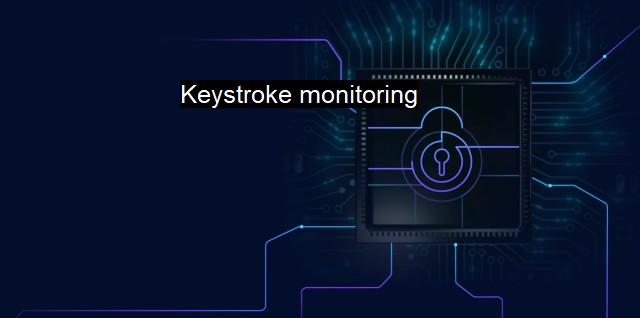What is Keystroke monitoring?
The Importance and Implications of Keystroke Monitoring: From Cybersecurity to Corporate Surveillance
Keystroke monitoring, also known as keylogging, is a cybersecurity method used to track or log the keys struck on a keyboard. Typically covert by nature, its purpose is to closely observe each typing movement a user- an individual, a group, or an entire organization, makes on a computer or a network system.The application of keystroke monitoring serves as both a protective conduit and weapon of destruction contingent on who uses it and for what purpose it is used. Broadly, keystroke monitoring is applied extensively in two distinct realms. First, in the cybersecurity landscape, it promotes organizational security and discourages unauthorized access, tracing the hackers, and combatting cybercrimes. The second realm lies in the espionage and surveillance domains, chiefly from harmful intentions like dishonest cyber activities, colluding, or stealing private information.
Keyloggers, as keystroke monitoring tools, are typically installed as hidden components on a computer system. Cybersecurity firms could leverage them to identify potential threats by tracking the cyber activity of users within their network. they can detect when someone enters sensitive or classified data into a potentially insecure site, or even when there's an unusual pattern of keyboard activity indicating process automation, malicious software, or hacking attempts.
Similarly, antivirus manufacturers configure their systems to understand keyboard entry patterns to gear against viral threats or malicious software. Keystroke monitoring is vital in the realm of antivirus protection because of the high susceptibility of computers to keyloggers. When malware or spyware manages to infiltrate a computer system, it often seeks sensitive information, such as financial details or passwords. This is accomplished through keyloggers hidden within the software. The antivirus, using keystroke monitoring, can identify and neutralize these threats.
The covert nature of keystroke monitoring has lent itself to instances of misuse, primarily at the hands of cybercriminals. These malicious entities utilize software attacks to exploit keylogging unsuspectingly and use the key-stroke logged information to perpetrate illegal activities like identity theft, fraud, or filled ransomware attacks.
Keystroke monitoring can also trespass personal privacy. some employers monitor keyboard activities to ensure productivity but could end up violating the employee’s privacy. Legal boundaries differ significantly across geographic boundaries and industries when it comes to keystroke monitoring, with governing bodies or institutions trying hard to strike a balance between security requirements and privacy protections.
In light of these ambiguous security-privacy interplays, good cybersecurity practices advocates being watchful of the usage of keystroke monitoring. These practices also press upon using state-of-the-art antivirus software that offers comprehensive protection from various online threats, including keyloggers.
To minimize the risk of unintended keystroke monitoring, it is recommended that individuals regularly update and maintain their antivirus software while also adopting protective measures such as using trusted antivirus protection tools, strong passwords, and secure networks.
Lastly, in the era of sophisticated cybersecurity threats, precautions with keystroke monitoring cannot be understated. Businesses, in particular, owe a responsibility to uphold a cyber-resilient framework that weighs the benefits of keystroke monitoring for enhanced security against respecting the necessary private boundaries of their employees and stakeholders. The statutory authorities, too, play a pertinent role in this aspect by shaping the legal landscape for balancing increased security paradigms and essential privacy protections.
Keystroke monitoring, while invaluable in ensuring cybersecurity and facilitating antivirus measures, pedals on a thin line dividing secure oversight from privacy infringement. An informed, careful, and respectful approach to keystroke monitoring can result in a robust cybersecurity framework that complements our increasingly digitized world.

Keystroke monitoring FAQs
What is keystroke monitoring in cybersecurity?
Keystroke monitoring is the process of tracking and recording every key pressed on a keyboard, used mainly for security purposes. It is used to monitor user activities, identify malicious activities like data theft, and prevent unauthorized access to sensitive information.Why is keystroke monitoring important for antivirus software?
Keystroke monitoring is important for antivirus software because it helps to detect and prevent malware that may attempt to capture sensitive information through keystroke logging. It can also be used to monitor employees' activity to ensure they are not engaging in any risky behavior that could compromise the company's security.Is keystroke monitoring legal?
Keystroke monitoring is legal, but it must be done in compliance with relevant laws and regulations. In most cases, it is legal if the employer has informed the employees that their activities are being monitored and the monitoring is being done for legitimate security purposes. It is important to consult a lawyer or legal expert before implementing keystroke monitoring in the workplace.How can I protect myself from keystroke monitoring?
To protect yourself from keystroke monitoring, you can use anti-keylogger software that detects and removes keystroke loggers from your computer. You can also be cautious when downloading and installing software, as many keyloggers and malware are disguised as legitimate programs. Additionally, use strong passwords for your accounts, enable two-factor authentication, and be wary of phishing scams that aim to steal your login credentials.| | A | | | B | | | C | | | D | | | E | | | F | | | G | | | H | | | I | | | J | | | K | | | L | | | M | |
| | N | | | O | | | P | | | Q | | | R | | | S | | | T | | | U | | | V | | | W | | | X | | | Y | | | Z | |
| | 1 | | | 2 | | | 3 | | | 4 | | | 7 | | | 8 | | |||||||